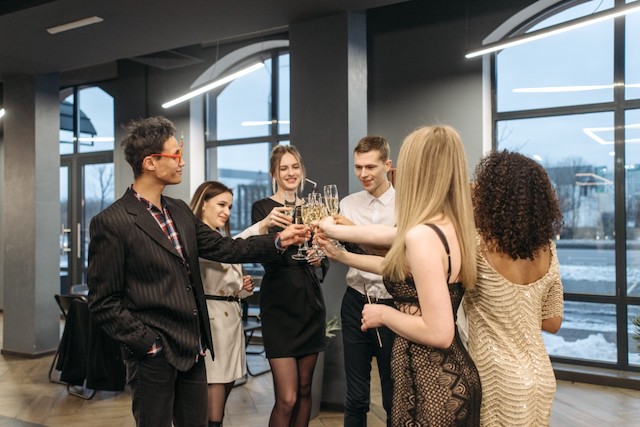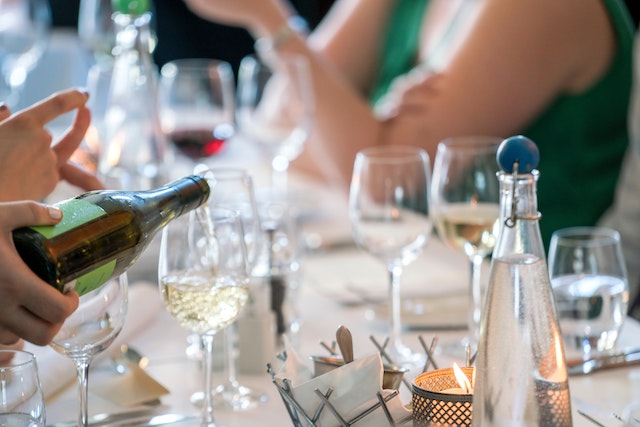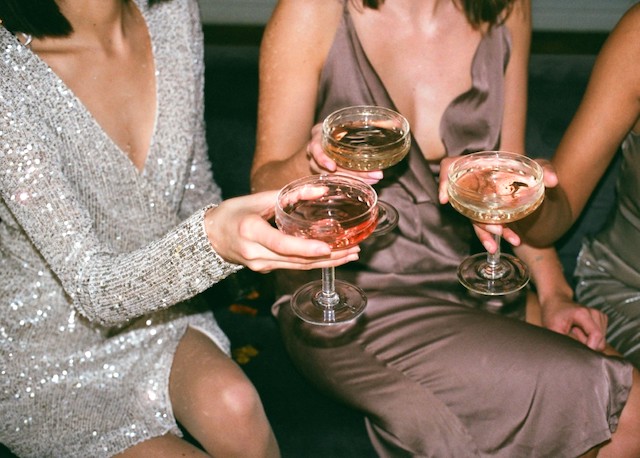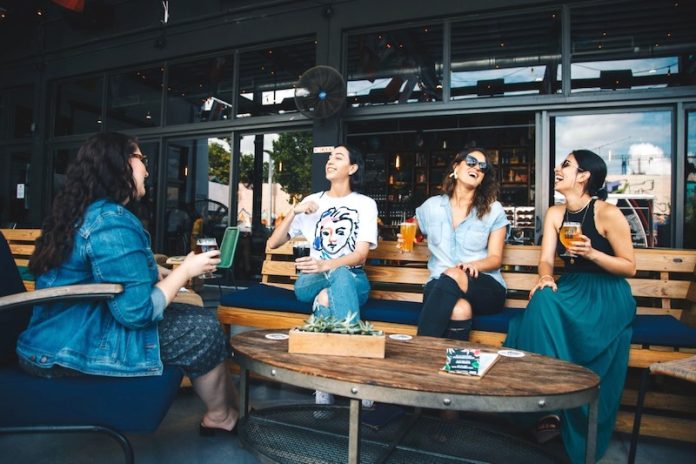How the increase in non-alcoholic drink options on the market is making moderation easier for Aussies
The days always feel hotter in suburbia than they do on the coast. Even in Belrose, a Sydney suburb that locals will confidently boast as the Northern Beaches, despite it still being a 15-minute drive to the water.
It’s only 8am on a Saturday and you can already see the relentless suburban sun reflecting off the asphalt carpark outside the Bayfield’s liquor store. But the sticky heat is a blessing for a bottle-o, a key ingredient to ensuring all tills will be pumping later on. It’ll be a perfect arvo to ‘crack a cold one’.
Brianna Layton, long-time worker at her family managed store, is getting ready for the weekend rush as she restocks an end-of-aisle display with the new release by popular brewer Heaps Normal. But it’s not a regular beer they’re promoting, it’s a non-alcoholic alternative from the craft brand. “In terms of non-alcoholic, every week we probably almost double the amount that we sell. It’s crazy,” she says.
With a nod so confident that untamed red curls fall loose from her hair tie, Layton’s lips disappear as she laughs and says, “Yeah, it honestly does surprise me how much we sell”.
Although it’s not really a surprising fact, according to the latest report from IWSR Drinks Market Analysis, which for the last 50 years has been the leading source of data for beverage alcohol trends globally.
In 2021, IWSR anticipated that no/low alcoholic consumption would increase by more than 31 per cent by 2024. Their most recent study earlier this year confirmed this trend indicting that no/low alcohol had reached almost US$10 billion in value by the end of 2021, continuing to outperform full alcohol in overall beverage growth.
The moderation trend sweeping the globe can be put down to a “cultural shift”, says Layton. Between the indisputable physical and mental health benefits, the cheaper cost and the convenience of non-alcoholic alternatives, Australians are increasingly finding more reasons not to drink.
Layton, perched on her Kmart swivel chair behind the register, has a bird’s eye view of the store. Prime position for observing, and on the rare occasion judging, her customer’s purchases.
Beer and cider, at a 75 per cent volume share, are driving the boom in the no/low alcohol market, according to the IWSR study. This makes sense, because beer brands have been working in the non-alcoholic sector for the longest. Initially it was large brands in Australia like Heineken and Coopers that were the first to bring out non-alcoholic options, however Layton says more recently the craft sector has wanted to join the trend.
“Customers are loving the craft options, and I think it’s because they’re trying to emphasise taste,” she says. “They are putting more time and effort into the process to get that same high quality as the alcoholic version, which takes a lot longer and more effort.”
This effort is reflected in the high price point of non-alcoholic craft beers, which are almost identical to the price of the alcoholic options. Customers looking to save can opt for the mainstream brands, where the non-alcoholic alternative can be $10 cheaper than a regular strength six pack.
As for the non-alcoholic wine sector, Layton says, “I still think they have a long way to go.”
Most people end up buying five different brands to find one they enjoy, because they’re either “too sweet, too light or too fruity even”, she says.
Some just taste like Ribena.
“Of the ones I’ve tried, they definitely feel like a summer drink. Think of sitting around a pool, they’re very refreshing. You could put ice in it and I don’t think it would make much of a difference to the taste.”
But this sets off alarm bells, a worrying sign of an undeveloped flavour profile. Ice in a chardonnay? It’s a cardinal sin. Any sophisticated wine drinker would not dare.
At 8pm on a Wednesday, at Sydney’s prestigious Establishment Bar on George Street, the effects of alcohol are in full force. I get the sense non-alcoholic options are not on the menu tonight.

Two young women in Jimmy Choos potter about with espresso martinis, that they definitely did not pay for, in their delicately manicured hands. A few older men, with glassy eyes and half-empty schooners, have attempted to squeeze their backsides into the tottering bar stools at a high table. Off in the corner there’s a loud group settled in for the evening, and a man with his top button undone and a wicked grin is popping a third bottle of Moet. Bubbly served without ice, of course.
Zoe, an account executive, fits in well with this corporate crowd. One of the countless Sydneysiders returning to the office post-covid, she celebrates the end of another long day with her drink of choice, a G&T. Her piercing blue eyes shaped by gloriously thick and unruly eyebrows, stare out at the sea of people, not down at her phone, while she sips.
There is a strong drinking culture in Australia, especially in the corporate scene. Whether it’s a work event, a conference, a dinner with clients, or even general socialising with the office team.
“Alcohol is always going to be present, and it’s kind of expected that you have a drink. I feel that pressure,” says Zoe. “The tone is determined by your superiors. If they’re getting a bottle of wine, you don’t really feel like you can switch to the non-alcoholic option.”
But Zoe does not want to get drunk with colleagues, out of fear it will seem unprofessional and potentially embarrassing. Who wants to be put in an Uber by their boss? Alcohol makes us lose our inhibitions, which doesn’t fit with Zoe’s anxiety around always wanting to be in full control, “especially if I’m around people I want to impress”.
Anxiety associated with drinking is complex. While a mental health illness can lead someone to drink for short-term relief, often in the long-term alcohol can exacerbate underlying stresses. There is no causal relationship between alcohol and mental health illnesses. Yet terms like ‘hangxiety’ and ‘headnoise’, used to describe that post drinking feeling, have become commonplace in our vocabulary.
“I definitely replay the events of the night before in my head,” says Zoe. “I just end up feeling pretty shit the next day.”
According to the Australian Institute of Health and Welfare (AIHW), the number of alcohol induced deaths has continued to rise, by 8 per cent in 2020.
Alcohol, accounting for 4.5 per cent of the total burden of disease in Australia, is still a leading factor contributing to premature death. Alcohol was responsible for 40 per cent of deaths from liver cancer, 19 per cent of deaths from liver disease and 14 per cent of deaths from suicide. Embarrassingly, the highest number and rate of ambulance attendances is still related to alcohol intoxication.
We’ve been hearing it for years, but clearly, Australians still have a problem with alcohol.
Regardless of the distinct health issues that the consumption of alcohol threatens to induce, Rose-Mary Forrest could think of nothing worse than giving up her drink.

She has a shrunken demeanour and veiny hands that shake uncontrollably, still, her maroon cat-eye glasses and the scent of Chanel no. 5 indicate she was once a woman of the hour. With a faint voice that comes and goes in strength, she explains how underlying health reasons have led her to limit her alcohol consumption.
While she seems the perfect candidate for a non-alcoholic beverage alternative, she refuses to give it a go. “My drink is what I look forward to every day, a sherry with cheese and bikkies and the 6 o’clock news.”
Even though she no longer works in her clerical role, it is the ritual of having a drink in the evening to de-stress that Forrest would miss. “There is no point in having good physical health if it means getting rid of all the things you love.”
Layton agrees it is people at the extreme ends of the age spectrum, the young and old, who are less inclined to try non-alcoholic alternatives. “We get so many oldies that come in every Monday at 10am to buy their cask of wine, because that’s what they’ve been doing for the last 100 years.” Out of habit, they won’t even change from a Sauvignon Blanc to a Pino Gris, let alone switch to non-alcoholic all together.
As for the younger demographic Layton says, “I literally don’t recall selling any non-alcoholic drinks to anyone under the age of 25.” A lot of young Australians are binge drinkers, wanting to feel the full effects of alcohol by drinking to excess over the weekend.
Layton says: “All of them always ask what drink has the most standards in it. They’re always looking for the highest alcohol content at the cheapest price.”
It is this “drink to get drunk” mentality among young people that supports the IWSR finding which states, “many no/low brands targeting late night partying and dark spirits occasions have found it tougher to gain consumer acceptance.”
///////////////////////////////
The key demographic of non-alcoholic drinkers according to Brianna is middle aged people, ranging anywhere from mid 30s-60s.
Many people start drinking non-alcoholic alternatives during a self-imposed dry month, and then eventually see no reason to go back to regular alcohol. People are continually choosing non-alcoholic alternatives, whether it be out of familial responsibilities to young children, a midlife crisis health kick, supporting a pregnant partner, wanting to drive more or attempt to save money.

Interestingly, it is “evening occasions at home” when the IWSR study found most people will opt for a non-alcoholic alternative. Post-exercise, at mealtimes, and to unwind at home are other popular reasons among consumers.
Layton remembers thinking a few years ago when the non-alcoholic trend kicked off, “Why bother drinking at all? Why not just have a diet coke?” It’s a sentiment that resonates with many Aussies, who have not yet tried non-alcoholic beverage alternatives.
But it’s all about the social aspect, she says. Imagine standing at a function or at a dinner with friends, holding a can of solo instead of a can of beer. “It’s kind of the psychology behind the adult’s drinks, and the kid’s drinks.”
Zoe agrees that, “when you turn 18 it’s an exciting time”. Finally young adults get to legally move away from the fruit juice and soft drink. “You automatically want to go out and drink, and would feel so out of the circle if you were just drinking water.”
For others, it genuinely is the ‘realistic’ taste of non-alcoholic alternatives that keep them coming back for more. From chatting to customers in the past, Layton says a lot of men in particular simply “crave that beer taste”. She says, “They’ve been drinking it for so long, and that’s what quenches their thirst.” It’s all about feeling satisfied.
Non-alcoholic beverage alternatives are also just as accessible as soft drink and juice these days, since increasingly they can be found on supermarket shelves. The convenience of ducking into one store, as opposed to going somewhere separate for alcohol, is handy for busy people. It also means those suffering from addiction can buy their drinks without being tempted by the alcoholic version sitting right next to it on the shelf.
“I think it’s all part of the larger push in Australian society becoming more health conscious,” Zoe says.
While recognising the benefits for society more widely, Layton has some concern that the non-alcoholic industry takes away from businesses that sell alcohol.
“Woolies and Coles have their own thing going on! They can leave the drinks, alcoholic and non-alcoholic, to us.”


